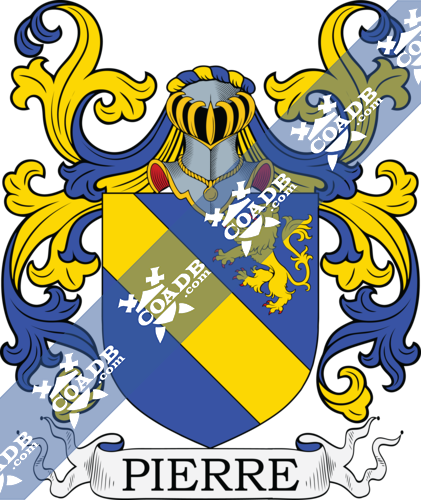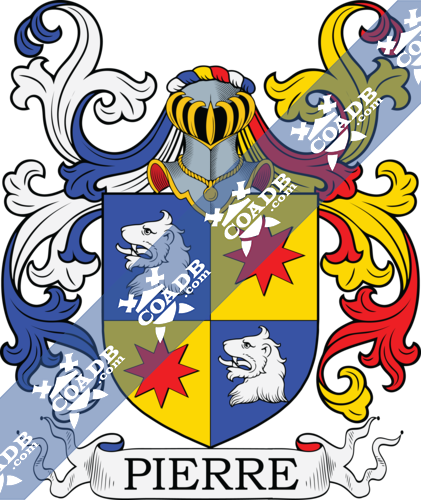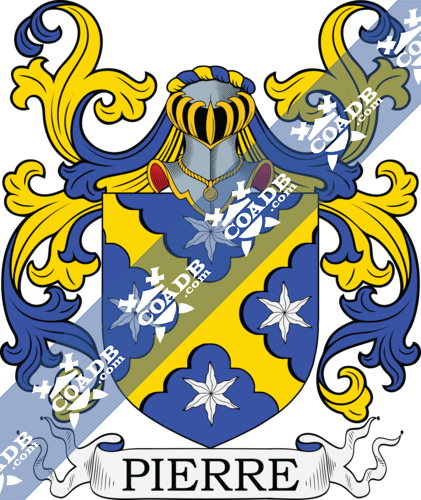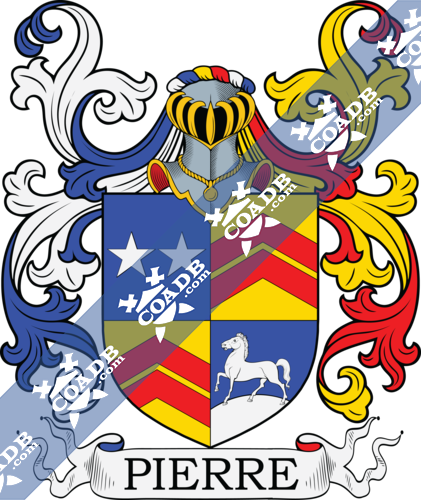Pierre Family Crest, Coat of Arms and Name History

Pierre Coat of Arms Gallery
Don’t know which Coat of Arms is yours?
We can do a genealogical research. Find out the exact history of your family!
Learn MoreSurname Name Meaning, Origins, and Etymology
The family name has several origins: patronymic, link to South of France local nobility (under the form ‘de Pierre’), locational and characteristic.
The patronymic family name is simply the given name used as a surname (the most common form for patronyms in France). Pierre (i.e. Peter in English) derives from Petrius in Latin, itself from Petros in Koine Greek, ultimately an adaptation of Jesus’s disciple nicknamed Kephas (meaning stone or rock, real name Simon). The French given name is one of the few to converse it’s relation to the actual meaning of the name, as a stone or rock is also a pierre in French. As one of Jesus’s closest disciple, and first bishop of Rome, the name naturally became a staple from the 4th century onward in the Roman Empire and Later in France. As such, when family names started to be adopted in the 11th and 12th century in medieval France, the popular given name became widespread among the French as family name. Many diminutive have also been used and passed on as patronyms: Perreau, Perret, Perrineau, Perrinet, Perriot, Perron, Perrot, Perrod, Perroud, as well as regional forms of the name: Peyre (Occitan), Pier, Pere (Catalan), Petru (Corsican), Peter (Alsace, Moselle), Peeter, Pieter (Flemish).
The ‘de Pierre’ family from the South of France is attested in the 11th century, taking part in the first crusade.
Pierre, or La Pierre, or de la Pierre, is a locational name for people living close to a remarkable stone. Alternatively, Pierre and la Pierre are also nicknames, likely given for strength or endurance, later turned into a surname.
Early Bearers of the Surname
The family name is not present in the Domesday, likely because the use of patronyms was not yet widespread in France. And while present in muster rolls on the English side during the Hundred Year War, all the bearer seems to have come from Normandy. The family name made its entrance in the U.K. during the Huguenot exile to England in 16th and 17th century. Early marriages involving this surname includes Edward Pierre to Anne Owen at St Botolph Aldgate, London in 1617, Sampsone Pierre to An Potter at Saint Botolph Bishopsgate, London in 1605 and Ursula Pierre to John King at Woodchurch, Kent, England in 1629.
History, Genealogy, and Ancestry
Guillaume de Pierre died during the first crusade in 1098 at Tyr (today in Lebanon). The family became more prominent with the ‘de Bernis’ branch in the 18th and 19th century, serving as archbishops and military officers in the Revolution, Napoleonic and Restauration wars. Charles La Pierre, born about 1676 in Westminster, London England, married Magdeleine Le Noir in 1701.Together they had two children: Charles (1704-1763) and Magdeleine (born 1706). The family later moved to Amsterdam, The Netherlands.
Early American and New World Settlers
As a common surname Pierre naturally spread to French colonies from the 16th century onward. It is attested in New Orleans and Montreal in the early 18th century.
Motto
De Pierre’s motto is Armé pour le roi, meaning armed for the King.
Grantees
I haven’t found any record of grantees in the UK armorials up to the late 19th century.
Notables
Famous people includes 1) Percy A. Pierre (born 1939), American electrical engineer and mathematician, 2) Jean Baptiste Louis Pierre (1833-1905), French botanist, 3) François-Joachim de Pierre de Bernis (1715-1794) French cardinal and diplomat, 4) Raymond Pierre (born 1967) an American track and field athlete, Pan American games gold medal.
Blazons & Genealogy Notes
1) Lorraine – (An., 10 mai 1607) De gueules à trois pierres d’argent. English: Gules three stones argent.
2) Lorraine – (An, 19 avril 1576) Écartelé aux 1 et 4 d’azur à une tête de lion d’argent aux 2 et 3 d’or à une molette (8) de gueules. English: Quarterly 1st & 4th azure a lion’s head argent 2nd & 3rd or a mullet of eight points gules.
3) Lorraine – (An., 10 oct. 1619) D’argent à la fasce engrelée d’azur ch de trois étoiles d’or et acc de deux têtes de lion de sable 1 en chef et 1 en pointe. English: Argent a fess engrailed azure charged with three etoiles or and surrounded by two lion’s heads sable 1 in chief and 1 in base.
4) Paris D’azur à un pierrot ou passereau d’argent acc de trois étoiles du même. English: Azure a sparrow (or different word for sparrow) argent surrounded by three etoiles of the same.
5) Lorraine – (An., 1743) D’azur au sautoir engrelé d’or cantonné de quatre étoiles d’argent. English: Azure a saltire engrailed or in each quarter (of the saltire) an etoile argent.
6) Alais, Languedoc – (Arm. gén. de 1696) Jean P. marchand D’azur au chevron d’or acc de trois rochers d’argent 2 en chef et 1 en pointe. English: Azure a chevron or surrounded by three rocks argent 2 in chief and 1 in base.
7) Bourgogne – (Arm. gén. de 1696) Louis P. secrétaire du Roi D’azur au lion d’or acc de trois pierres précieuses d’argent taillées à facettes posées 2 et 1. English: Azure a lion or surrounded by three precious stones argent cut into facets place 2 and 1.
8) Franche-Comté – (An., 1556) D’azur à trois croissants versés d’or 2 et 1 et quatre étoiles du même 3 sous les croissants et la quatrième en pointe. English: Azure three crescents inverted or 2 and 1 and four etoiles of the same 3 under the crescent and the fourth in base.
9) France – (Baron de l’Empire) Écartelé au 1 d’azur à deux molettes d’argent rangées en bande aux 2 et 3 d’or à deux chevrons de gueules au 4 d’azur à un cheval d’argent passant sur une terrasse du même. English: Quarterly 1st azure two mullets argent in fess 2nd & 3rd or two chevrons gules 4th azure a horse passant argent on a mount of the same.
10) de Pierre – Neufchâtel – (An., 1730) D’azur à un huchet d’or l’embouchure à dextre la courbe ornée en bas de trois houppes de sinople Casque couronné Cimier une tête et col de lion d’or posée de front entre un vol de sable Lambrequin d’or et d’azur. English: Azure a hunting horn or the mouthpiece to the dexter the curve (part of the horn) decorated on the lower part with three tassels vert Crowned with a helmet Crest the head and shoulders of a lion affronte or between a pair of wings sable Mantling or and azure.
11) de Pierre – Normandie – (Saint-Allais) De gueules à l’aigle d’or. English: Gules an eagle or.
12) de Pierre – Dauphiné (Gapençais) – Famille ét. D’azur à trois billettes d’or au chef cousu de gueules chargé d’un croissant d’argent. English: Azure three billets or a chief (sewn on) gules charged with a crescent argent (“cousu” in the original makes no visible difference, just acknowledges the broken rule of no colour-on-colour).
13) de Pierre – Marquis de Bernis – Languedoc – (Marquis, avril 1751) D’azur à la bande d’or acc en chef d’un lion du même armé et lampassé de gueules Devise ARMÉ POUR LE ROI. English: Azure a bend or accompanied in chief by a lion of the same armed and langued gules Motto ARMÉ POUR LE ROI.
14) (Pierre-Bussiere). Limousin De sable au lion d’or. English: Sable a lion or.
15) Pierre-Cise (ou Rochetaillée) – Genève De gueules à la bordure engrelée d’or à la bande du même brochant sur le tout et ch de trois dauphins de sable posés chacun en barre. English: Gules a border engrailed or a bend of the same over all and charged with three dolphins sable each bendwise sinister.
16) de Bernis (de). Languedoc – Sgr. des Ports.; Cachet de 1740 Supports deux lions tenant chacun une épée. English: Same as the Arms of Marquis de Bernis; Supporters two lions each holding a sword.
17) de Franay – Bourgogne, Nivernais D’azur à une clé d’argent posée en barre et un bourdon de pèlerin d’or brochant en bande acc en chef d’une étoile d’argent et en pointe d’une coquille d’or. de Saincy – Bourbonnais Les armes de Pierre de Franay. English: The arms of Pierre de Franay. English: Azure a key argent bendwise sinister and a pilgrim’s staff covering it bendwise or surrounded by, in chief an etoile argent and in base an escallop or.
18) (de) de Giez – Neufchâtel D’or à la bande de sable coticée de gueules. English: Or a bend sable cotticed gules.
























